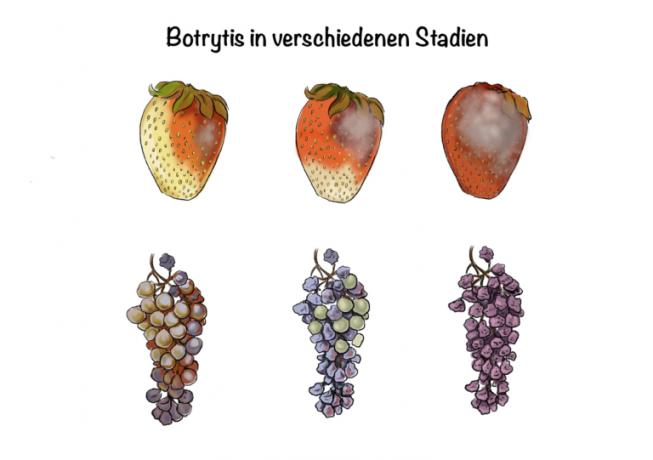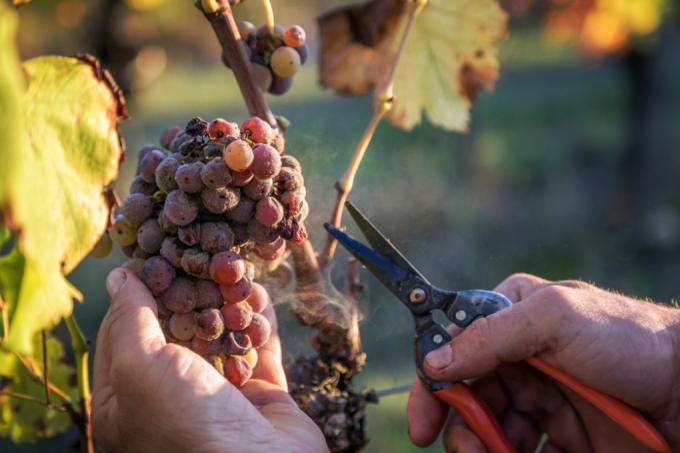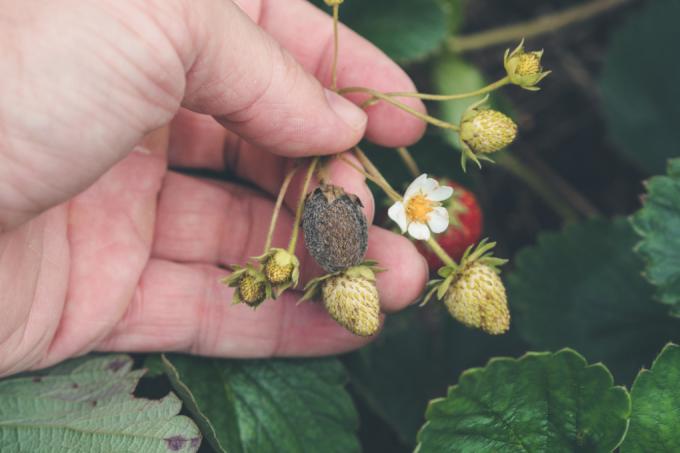the essentials in brief
- Botrytis cinerea is also known as gray mold or gray rot. It is a common fungal disease.
- The pathogen multiplies explosively, especially in warm and humid weather. It has a wide range of hosts; almost all garden and indoor plants can be infested.
- However, fruit vegetables, berries and ornamental shrubs, mainly tomatoes, cucumbers and strawberries, are particularly at risk.
- Effective protection consists in specific preventive measures, especially the humidity should not get too high.
What is botrytis?

Botrytis is particularly feared in viticulture
The gray mold or gray rot is caused by the frequently occurring and very adaptable hose fungus Botrytis cinerea. The harmful fungus has a wide range of hosts and therefore affects not just a few plant species, but well over 200 different ones. The occurrence of gray mold in viticulture is particularly problematic, because here an infection can destroy a previously promising harvest in no time at all. Here the plant disease is also called noble or Raw rot, as it often hits unripe grapes.
also read
- Recognize pear rust, prevent and fight effectively
- Boxwood pests: recognize fleas and fight them effectively
- Grass mites - detect, control and prevent
Botrytis cinerea feels most comfortable at warm temperatures of 22 degrees Celsius and above, especially when the air humidity is high, the disease develops rapidly. Since it is usually both warm and humid in greenhouses, gray mold is very common here - daily ventilation is essential to prevent this. But the fungus can also cause infections in the garden and in indoor culture if the climate is right. For this reason, you should take appropriate precautions in warm and humid summer weather and watch your plants carefully.
Damage: Detect botrytis in good time
In the case of an infestation with botrytis, it is primarily flowers - which is why one sometimes speaks of bud rot - and fruits that are affected. In principle, however, all parts of the plant, including lignified branches and young shoots, can be infected. This damage pattern is characteristic:

- Formation of a gray fungal lawn on infected parts of the plant
- Fungal lawn is very dusty when it is touched, as spores emerge
- Death of plant tissue
- Formation of brown spots on affected parts of the plant
- especially fruits look glassy at the onset of the disease
- Occurrence of ghost spots on tomatoes
The ghost spots in Botrytis are a special phenomenon in tomatoes. A bright center develops on the infected fruit, which in turn is surrounded by an equally bright ring.
Where does the disease come from and how does it develop?
Youtube
The initial infection with Botrytis often takes place in favorable weather conditions - humidity over 85 percent and temperatures between 15 and 25 degrees Celsius - by wind and rain. Both of these transmit the mass produced spores from already infected plants or from the soil. The fungal spores penetrate the plants and fruits through the smallest wounds and injuries, whereby an infection basically occurs in everyone Stage of development and is possible at any time of the year - even in winter, whereby fruit trees in particular are endangered after the winter pruning are.
The fungal spores either overwinter on infected parts of the plant (e. B. leaves and fruits remaining on trees and bushes) as well as in the form of a mycelium in the soil. Here Botrytis feeds on dead plant parts and remains permanently in the ground. The spores mainly form in spring, which is why infection is most likely at this time of the year. Weakened plants that can no longer defend themselves against the invasion of the pathogen are particularly at risk.
Most of all, this hits through
- unsuitable growing conditions
- an unsuitable location
- too narrow a plantation
- a cold resp. wet winter
- or through incorrect fertilization (v. a. Overfertilization)
previously damaged plants.
Digression
Which plants are particularly at risk from botrytis?

Strawberries are often attacked by gray mold
In the home garden, crops that are particularly endangered by botrytis are - in addition to grapes - many berry fruits such as strawberries, raspberries, blackberries and gooseberries. Furthermore, it mainly affects vegetables cultivated in greenhouses, especially tomatoes, cucumbers, lettuce and onions. But even ornamental plants are not immune to gray mold, because roses, Hydrangeas, Rhododendrons and tulips are also endangered. In principle, however, the fungal disease can occur on almost all garden and indoor plants.
Effectively prevent botrytis
Since the botrytis fungus requires sufficient moisture for infection and for it to spread, you should go through preventive measures Measures for a quick drying of all parts of the plant after a downpour and generally for a lower humidity care for. The following table gives you an overview of effective measures for plant hygiene.
| measure | execution |
|---|---|
| Reduce humidity | Avoid locations with high humidity, ventilate greenhouses, conservatories and apartments (with indoor plants) frequently |
| Proper watering and watering | When watering, always pour on the ground, do not wet leaves, shoots and flowers, prefer appropriate watering systems (drip irrigation instead of sprinkler systems) |
| Proper fertilization | moderate fertilize and above all avoid over-fertilization with nitrogen, prefer organic fertilizers |
| Thinning out and other editing measures | Keep plants loose and airy, cut back excessively close growth, immediately cut back infected or injured / damaged shoots |
| Mulching | floor mulchto retain moisture in the soil and reduce evaporation |
| Hygiene measures | Removal of fallen leaves, fallen fruit and fruit mummies, disinfect cutting tools |
| Pest Control | many pests are Carrier the disease and / or weaken the plants, which is why any infestation must be combated at an early stage |
| Keep the planting distance | Pay attention to a generous planting distance when planting, do not place plants too closely |
In addition, you can strengthen the immune system of endangered plants so that the fungus does not grow in the first place Has a chance of infection - strong plants are less likely to get sick because they are better suited to the pathogen resist. For this purpose, a spray with self-made, silicate-containing ones is suitable Herbal manure the end Field horsetail, which you carry out regularly after budding and during the growing season at intervals of 10 to 14 days. A spray made on the basis of sulphate of alumina also shows good results as a preventive measure.
Digression
Similar clinical pictures
How to fight botrytis

Infested parts of the plant should be removed promptly with great care so that the spores do not spread any further
Check your plants regularly for signs of botrytis and other plant diseases so that you can quickly take countermeasures in the event of an infection. It is important to act quickly to prevent the fungus from spreading further - otherwise other plants will be affected in no time at all. How to take action against botrytis gray rot:
- Immediately remove all diseased parts of the plant
- Cut off twigs and shoots right into the healthy parts
- Reduce humidity (if possible, e.g. B. in the greenhouse)
- isolate affected plants (if possible, e.g. B. for indoor plants)
- If the infestation begins, spray horsetail broth
- alternatively plants with Primary rock meal pollinate
Furthermore, these measures help well against botrytis (and other plant diseases):
- Always place plants in mixed culture
- especially with garlic, as this keeps pathogens away
- Move strawberries and other crops at least every three years
- Note crop rotations
Before planting, add some finely chopped garlic to the planting hole (for example with strawberries), and do not spread the straw until after flowering. Both of these can effectively prevent a botrytis infection.
Spraying agents approved for the home garden
"Chemical agents must remain the exception and only be used when nothing else helps - the undesirable side effects are enormous."
Many gardeners fear for their harvest when botrytis occurs and would like to kill the fungus with the chemical club. The intention is understandable - who likes to cherish and care for their tomatoes and then throw them in the trash? - However, the use of chemical fungicides should be viewed critically for various reasons.
One important reason that speaks against the use of fungicides is the great adaptability of Botrytis - the fungus forms very quickly Resistances, which is why you actually only use the chemical club in the event of a very strong and otherwise uncontrollable infestation should. Always take the control measures already described first and take preventive measures as a matter of urgency.
If nothing else works, products with these active ingredients are approved for home gardening:
- Cyprodinil: for example Syngenta Switch
- Fludioxonil: Syngenta Switch contains both cyprodinil and fludioxonil
- Trifloxystrobin: for example Baymat Plus AF mushroom-free or Celaflor mushroom-free Saprol N
Otherwise there is the biologically active fungicide Prestop from Kwizda, which relies on the action of the soil fungus Gliocladium catenulatum.
When choosing the fungicide, make sure that it is bee-friendly. Neudorff AF Pilzfrei, for example, is effective against botrytis, but also dangerous for bees - the Hard-working insects are also killed by the agent, which is a lot before the current bee deaths is problematic.
frequently asked Questions
Is botrytis also dangerous for humans?

Gray mold rot can cause allergies in sensitive people
Botrytis cinerea has a high allergy potential and is therefore dangerous for people with a fungal allergy. This particularly affects people with a penicillin allergy. Protect yourself with appropriate clothing (mouth and nose protection to prevent inhalation, protective goggles, gloves, long clothing) as there are a lot of spores in the air.
Can I dispose of infected cuttings and fruits on the compost?
No, we strongly advise against this. The spores as infected parts of the plant find ideal living conditions in compost and multiply explosively there and with the distribution of the finished compost, further plants can be grown infect. If possible, dispose of contagious plant material with household waste or burn it.
Can you still eat slightly infected fruit if you cut away the moldy areas?
Consumption of infected fruits is also not advisable, on the one hand because the fungus strongly affects the taste of the fruit and on the other hand because it forms toxic substances that you would also eat. In particular, fruits that have not been ripe should be thrown away. During the winemaking process, grapes infected with Botrytis get into it from time to time, but this is not a problem due to the process of pressing and fermentation.
Tips
In addition, you should immediately cool freshly harvested berry fruits to temperatures between one and three degrees Celsius in order to kill any fungal spores that may be present. In addition, the fruits stay fresh longer.



